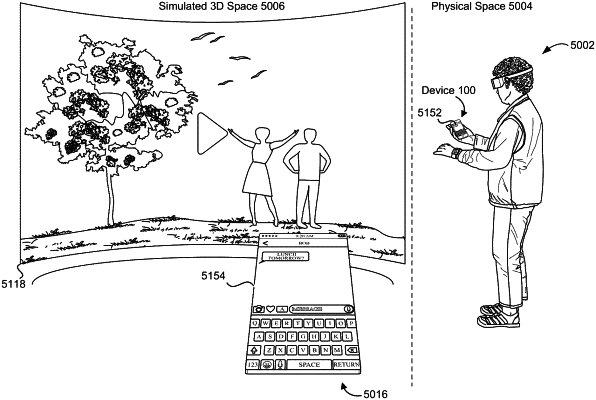| CPC G06F 3/04815 (2013.01) [G06F 3/0346 (2013.01); G06F 3/04886 (2013.01)] | 63 Claims |

|
1. A method, comprising:
at a computer system having one or more display generation components, wherein the computer system is in communication with an input device, one or more pose sensors for detecting respective poses of one or more of the input device and display generation components, and a computing device that is distinct from the computer system and that has a non-immersive display environment that provides access to a plurality of different applications:
displaying, via at least a first display generation component of the one or more display generation components:
a view of at least a portion of a simulated three-dimensional space; and
a view of a simulated user interface object that is located within the simulated three-dimensional space, wherein:
the simulated user interface object is a representation of the computing device that has the non-immersive display environment that provides access to the plurality of different applications;
the simulated user interface object includes a simulated first user interface that comprises a representation of the non-immersive display environment of the computing device and is responsive to touch inputs from a user on the input device; and
a pose of the simulated user interface object in the simulated three-dimensional space corresponds to a pose of the input device in a physical space surrounding the input device, and the simulated user interface object is moved in the simulated three-dimensional space in accordance with the user moving the input device relative to the physical space surrounding the input device;
detecting movement of the input device relative to the physical space surrounding the input device that changes an orientation of the input device;
in response to detecting the movement of the input device that changes the orientation of the input device, changing an orientation of the simulated user interface object and the simulated first user interface of the simulated user interface object in accordance with changing the orientation of the input device; and
while displaying the simulated three-dimensional space in a manner corresponding to a first application of the plurality of different applications, including displaying content of the first application in a portion of the simulated three-dimensional space that is outside of the simulated user interface object:
detecting a touch input at a location on the input device that corresponds to launching a second application, distinct from the first application;
in response to detecting the touch input on the input device:
displaying a user interface of the second application in the simulated first user interface on the simulated user interface object, while maintaining display of the simulated three-dimensional space in the manner corresponding to the first application, including maintaining display of the content of the first application in the portion of the simulated three-dimensional space that is outside of the simulated user interface object; and
while displaying the user interface of the second application in the simulated first user interface on the simulated user interface object:
detecting second movement of the input device relative to the physical space surrounding the input device that changes the orientation of the input device; and
in response to detecting the second movement of the input device that changes the orientation of the input device, changing the orientation of the simulated user interface object and the simulated first user interface of the simulated user interface object, including the user interface of the second application, in accordance with changing the orientation of the input device.
|